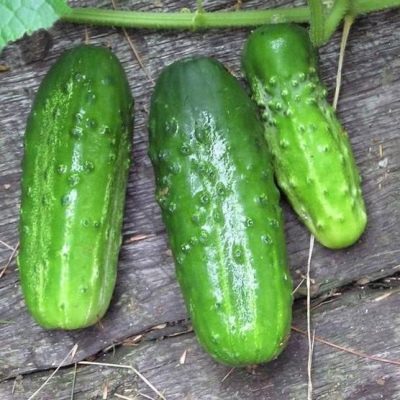
- Authors: domestic selection
- Year of approval: 1943
- Branching: weak
- Fruit weight, g: 100-140
- Fruit length, cm: 10-14
- Fruit color: light green
- Ripening terms: early
- Pollination: bee-pollinated
- Fruit shape: elongated ovate
- Fruit taste: good and great
Murom cucumber is known and loved by gardeners. This is a suitable variety for successful cultivation in the cool conditions of central Russia. Well, the taste of cucumbers resembles that very classic one from childhood.
Breeding history
It is known that the Murom cucumber was mentioned in the XIII century, it is believed that it was bred in Murom. Experts attribute this ancient variety to folk selection. At the same time, it was considered the best Russian variety, always maintaining high popularity, and was competitive on the international market in the 19th century. But after the revolution, Russia almost stopped selling seeds, and the area for cucumbers was significantly reduced. At the same time, the Muromsky variety began to mix with other varieties: Borovsky, Nerosimy.
In 1924, the first systematic measures to revive the Murom cucumber began. In the VIR collection in 1928, the Muromsky 36 variety was selected. The year of introduction of the variety into the State Register is 1943.
Description of the variety
The Muromsky 36 variety can now be seen throughout the entire territory of the Russian Federation, including the Urals, the Far East, and Siberia. The variety is bee-pollinated. Therefore, the optimal growing place is outdoors or using removable film shelters.
Characteristics of the appearance of plants and zelents
The plant is medium in size, the length of the main stem reaches 100–160 cm. The lashes are short.
The cucumbers themselves are small, 10–14 cm long, their diameter is 4–5 cm, and their weight is 100–140 g. They are round-oval or elongated-ovoid in shape. Against the background of a light green skin, black pubescence (the so-called thorns) stands out, and small tubercles are also present.
Purpose and taste of fruits
The flesh of Muromsky is characterized by an excellent taste, it is crispy and juicy. There is a pronounced cucumber aroma. The properties of the product are perfectly preserved when salted, the fruits are also good for fresh consumption.
Maturation
Cucumbers of the Muromsky 36 variety ripen 40–45 days after germination. This fact gives the right to call them early.
Yield
The average yield is 2-3.1 kg / m2, and it cannot be called outstanding.
Growing and care
Muromsky 36 is a rather unpretentious variety for the type of soil. But it is important for him that watering is sufficient, and there is oxygen access to the roots. But like any other cucumber plant, it will be grateful for the soil enriched with humus, light. Crops that are good as precursors to cucumber include corn, tomatoes, as well as peas and early potatoes. It is possible to grow Muromsky 36 both by seedling method, and sow seeds directly into the ground.
Since this is a variety, you can use seeds from your garden. For the seedless method, you should choose the largest seeds, which must be warmed up and disinfected before planting. Such treatment will strengthen the seed, and the seeds will sprout more amicably. It also positively affects resistance to various kinds of ailments and reduces the percentage of barren flowers.
Sowing seeds for seedlings is carried out in early May. It is better to transfer it to the ground in late May - early June, at the stage of 2-3 true leaves.After transplanting, the sprouts should be covered with a transparent film, creating a greenhouse, so you can protect the seedlings from possible frost. Sowing directly into the ground is carried out at the end of May. The main thing is that the earth is already completely warmed up, and its temperature does not drop below + 14 ° C.
The scheme of planting a Muromsky cucumber 36–40 by 40 cm. Weeds must not be allowed to overgrow the beds.
During the flowering period, irrigation is carried out once a week. From the beginning of fruiting, the procedure is speeded up, and feeding also begins. Fertilize Muromsky 4 times during the growing season. Among the dressings are urea, potassium sulfate, superphosphate, and mullein.
After 6-7 leaves appear, pinch the main stem of the plant. This stimulates branching and increases yield.

In order to collect strong, tasty and beautiful cucumbers on your site, you need to make top dressing. Lack of nutrients can negatively affect the appearance of the plant and significantly reduce the yield. Fertilize cucumbers with organic fertilizers in combination with mineral fertilizers. With the right balance of these components and adherence to the fertilizing schedule, the cucumber yield will be maximum.

Despite their popularity, cucumbers are often attacked by diseases and pests. From them, cucumber plantings often die before the start of fruiting. In order to prevent this from happening, it is necessary to try to prevent ailments or get rid of them at the very beginning, having studied in detail their causes of occurrence, signs and methods of treatment.





























































































